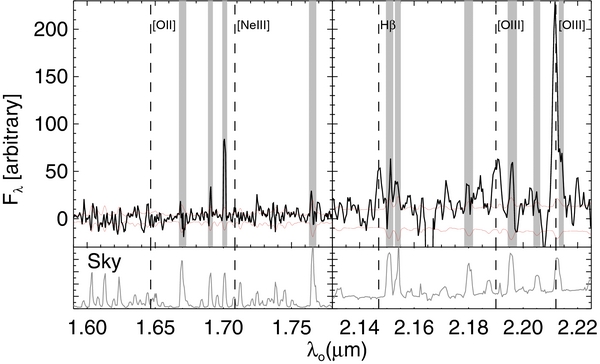We investigate the gas-phase metallicity and Lyman continuum (LyC) escape fraction of a strongly gravitationally lensed, extreme emission-line galaxy at z = 3.417, J1000+0221S, recently discovered by the CANDELS team.

LUCI/LBT H+K spectrum of J1000 + 0221 smoothed with the instrumental resolution. We show overplotted in red the 3σ noise spectrum. The position of both detected and undetected bright nebular emission lines are indicated by dashed lines. Shaded vertical regions show spectral regions affected by strong sky emission lines.
We derive ionization- and metallicity-sensitive emission-line ratios from H+Kband Large Binocular Telescope (LBT)/LUCI medium resolution spectroscopy. J1000+0221S shows high ionization conditions, as evidenced by its enhanced [O III]/[O II] and [O III]/Hβ ratios. Strong-line methods based on the available line ratios suggest that J1000+0221S is an extremely metal-poor galaxy, with a metallicity of 12+log (O/H) < 7.44 (Z < 0.05 Z ☉), placing it among the most metal-poor star-forming galaxies at z ![]() 3 discovered so far. In combination with its low stellar mass (2 × 108 M ☉) and high star formation rate (5 M ☉ yr–1), the metallicity of J1000+0221S is consistent with the extrapolation of the mass-metallicity relation traced by Lyman-break galaxies at z
3 discovered so far. In combination with its low stellar mass (2 × 108 M ☉) and high star formation rate (5 M ☉ yr–1), the metallicity of J1000+0221S is consistent with the extrapolation of the mass-metallicity relation traced by Lyman-break galaxies at z ![]() 3 to low masses, but it is 0.55 dex lower than predicted by the fundamental metallicity relation at z
3 to low masses, but it is 0.55 dex lower than predicted by the fundamental metallicity relation at z ![]() 2.5. These observations suggest a rapidly growing galaxy, possibly fed by massive accretion of pristine gas. Additionally, deep LBT/LBC photometry in the UGR bands are used to derive a limit to the LyC escape fraction, thus allowing us to explore for the first time the regime of sub-L* galaxies at z > 3. We find a 1σ upper limit to the escape fraction of 23%, which adds a new observational constraint to recent theoretical models predicting that sub-L* galaxies at high-z have high escape fractions and thus are the responsible for the reionization of the universe.
2.5. These observations suggest a rapidly growing galaxy, possibly fed by massive accretion of pristine gas. Additionally, deep LBT/LBC photometry in the UGR bands are used to derive a limit to the LyC escape fraction, thus allowing us to explore for the first time the regime of sub-L* galaxies at z > 3. We find a 1σ upper limit to the escape fraction of 23%, which adds a new observational constraint to recent theoretical models predicting that sub-L* galaxies at high-z have high escape fractions and thus are the responsible for the reionization of the universe.
The full paper can be found in Amorín et al. 2014, ApJ, 788, 4
